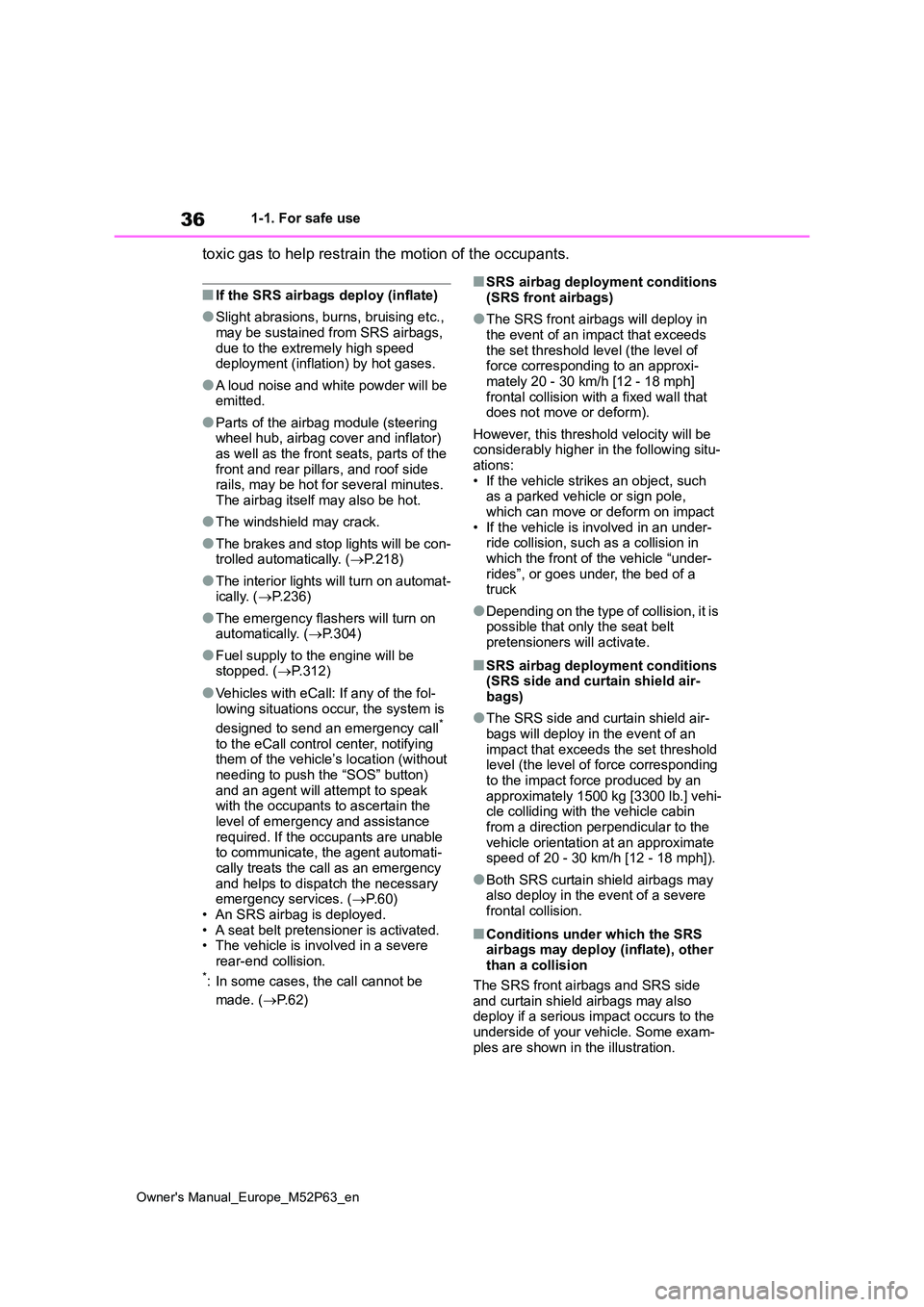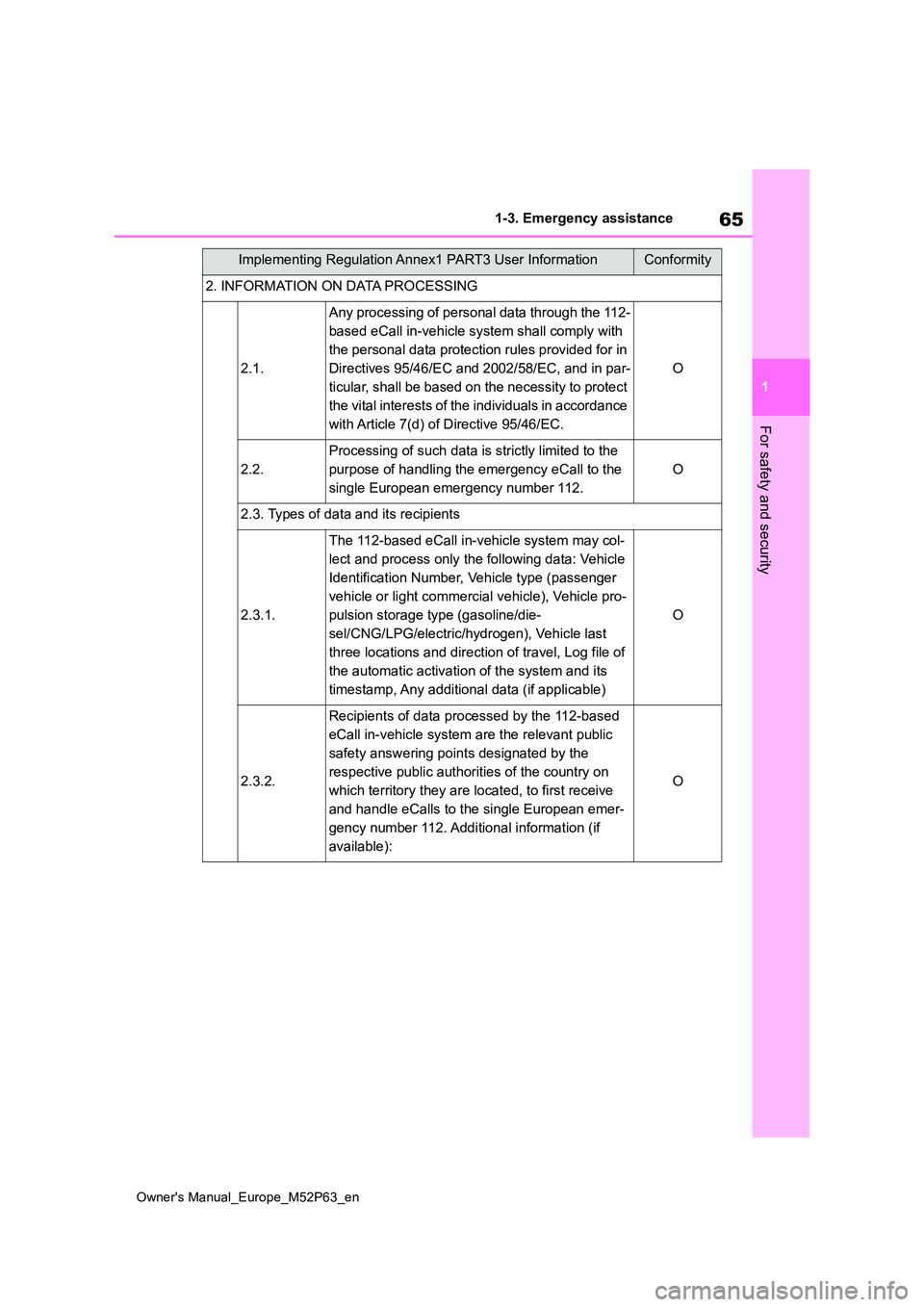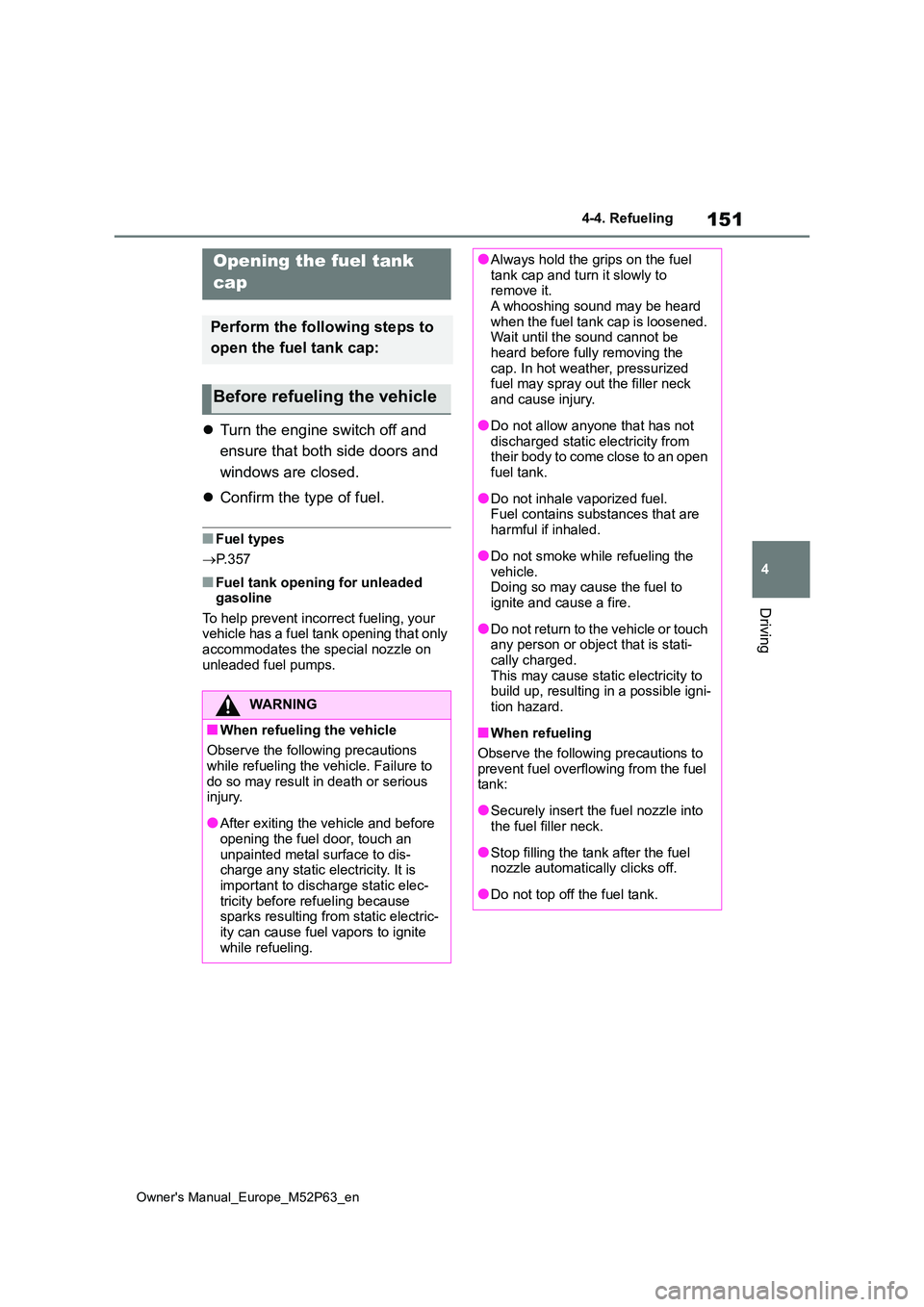2023 TOYOTA GR YARIS gas type
[x] Cancel search: gas typePage 38 of 470

36
Owner's Manual_Europe_M52P63_en
1-1. For safe use
toxic gas to help restrain the motion of the occupants.
■If the SRS airbags deploy (inflate)
●Slight abrasions, burns, bruising etc., may be sustained from SRS airbags,
due to the extremely high speed deployment (inflation) by hot gases.
●A loud noise and white powder will be emitted.
●Parts of the airbag module (steering wheel hub, airbag cover and inflator) as well as the front seats, parts of the
front and rear pillars, and roof side rails, may be hot for several minutes. The airbag itself may also be hot.
●The windshield may crack.
●The brakes and stop lights will be con-trolled automatically. ( P.218)
●The interior lights will turn on automat- ically. ( P.236)
●The emergency flashers will turn on automatically. ( P.304)
●Fuel supply to the engine will be stopped. ( P.312)
●Vehicles with eCall: If any of the fol-
lowing situations occur, the system is
designed to send an emergency call*
to the eCall control center, notifying them of the vehicle’s location (without needing to push the “SOS” button)
and an agent will attempt to speak with the occupants to ascertain the
level of emergency and assistance required. If the occupants are unable to communicate, the agent automati-
cally treats the call as an emergency and helps to dispatch the necessary emergency services. ( P.60)
• An SRS airbag is deployed. • A seat belt pretensioner is activated.• The vehicle is involved in a severe
rear-end collision.*: In some cases, the call cannot be
made. ( P. 6 2 )
■SRS airbag deployment conditions
(SRS front airbags)
●The SRS front airbags will deploy in
the event of an impact that exceeds the set threshold level (the level of force corresponding to an approxi-
mately 20 - 30 km/h [12 - 18 mph] frontal collision with a fixed wall that does not move or deform).
However, this threshold velocity will be considerably higher in the following situ-
ations: • If the vehicle strikes an object, such as a parked vehicle or sign pole,
which can move or deform on impact • If the vehicle is involved in an under-ride collision, such as a collision in
which the front of the vehicle “under- rides”, or goes under, the bed of a truck
●Depending on the type of collision, it is possible that only the seat belt
pretensioners will activate.
■SRS airbag deployment conditions (SRS side and curtain shield air-bags)
●The SRS side and curtain shield air-bags will deploy in the event of an
impact that exceeds the set threshold level (the level of force corresponding to the impact force produced by an
approximately 1500 kg [3300 lb.] vehi- cle colliding with the vehicle cabin from a direction perpendicular to the
vehicle orientation at an approximate speed of 20 - 30 km/h [12 - 18 mph]).
●Both SRS curtain shield airbags may also deploy in the event of a severe frontal collision.
■Conditions under which the SRS airbags may deploy (inflate), other than a collision
The SRS front airbags and SRS side and curtain shield airbags may also deploy if a serious impact occurs to the
underside of your vehicle. Some exam- ples are shown in the illustration.
Page 67 of 470

65
1
Owner's Manual_Europe_M52P63_en
1-3. Emergency assistance
For safety and security
2. INFORMATION ON DATA PROCESSING
2.1.
Any processing of personal data through the 112-
based eCall in-vehicle system shall comply with
the personal data protection rules provided for in
Directives 95/46/EC and 2002/58/EC, and in par-
ticular, shall be based on the necessity to protect
the vital interests of the individuals in accordance
with Article 7(d) of Directive 95/46/EC.
O
2.2.
Processing of such data is strictly limited to the
purpose of handling the emergency eCall to the
single European emergency number 112.
O
2.3. Types of data and its recipients
2.3.1.
The 112-based eCall in-vehicle system may col-
lect and process only the following data: Vehicle
Identification Number, Vehicle type (passenger
vehicle or light commercial vehicle), Vehicle pro-
pulsion storage type (gasoline/die-
sel/CNG/LPG/electric/hydrogen), Vehicle last
three locations and direction of travel, Log file of
the automatic activation of the system and its
timestamp, Any additional data (if applicable)
O
2.3.2.
Recipients of data processed by the 112-based
eCall in-vehicle system are the relevant public
safety answering points designated by the
respective public authorities of the country on
which territory they are located, to first receive
and handle eCalls to the single European emer-
gency number 112. Additional information (if
available):
O
Implementing Regulation Annex1 PART3 User InformationConformity
Page 153 of 470

151
4
Owner's Manual_Europe_M52P63_en
4-4. Refueling
Driving
4-4.Refuelin g
Turn the engine switch off and
ensure that both side doors and
windows are closed.
Confirm the type of fuel.
■Fuel types
P. 3 5 7
■Fuel tank opening for unleaded gasoline
To help prevent incorrect fueling, your vehicle has a fuel tank opening that only accommodates the special nozzle on
unleaded fuel pumps.
Opening the fuel tank
cap
Perform the following steps to
open the fuel tank cap:
Before refueling the vehicle
WARNING
■When refueling the vehicle
Observe the following precautions
while refueling the vehicle. Failure to do so may result in death or serious injury.
●After exiting the vehicle and before opening the fuel door, touch an
unpainted metal surface to dis- charge any static electricity. It is important to discharge static elec-
tricity before refueling because sparks resulting from static electric-ity can cause fuel vapors to ignite
while refueling.
●Always hold the grips on the fuel tank cap and turn it slowly to remove it.
A whooshing sound may be heard when the fuel tank cap is loosened. Wait until the sound cannot be
heard before fully removing the cap. In hot weather, pressurized fuel may spray out the filler neck
and cause injury.
●Do not allow anyone that has not
discharged static electricity from their body to come close to an open fuel tank.
●Do not inhale vaporized fuel.Fuel contains substances that are
harmful if inhaled.
●Do not smoke while refueling the
vehicle. Doing so may cause the fuel to ignite and cause a fire.
●Do not return to the vehicle or touch any person or object that is stati-
cally charged. This may cause static electricity to build up, resulting in a possible igni-
tion hazard.
■When refueling
Observe the following precautions to prevent fuel overflowing from the fuel tank:
●Securely insert the fuel nozzle into the fuel filler neck.
●Stop filling the tank after the fuel nozzle automatically clicks off.
●Do not top off the fuel tank.
Page 252 of 470

250
Owner's Manual_Europe_M52P63_en
6-1. Maintenance and care
WARNING
■Water in the vehicle
●Do not splash or spill liquid in the
vehicle. Doing so may cause electrical com-ponents, etc. to malfunction or
catch fire.
●Do not get any of the SRS compo-
nents or wiring in the vehicle interior wet. ( P. 3 4 ) An electrical malfunction may
cause the airbags to deploy or not function properly, resulting in death or serious injury.
■Cleaning the interior (especially instrument panel)
Do not use a polish wax or polish cleaner. The instrument panel may reflect off the windshield, obstructing
the driver’s view and leading to an accident, resulting in death or serious injury.
NOTICE
■Cleaning detergents
●Do not use the following types of detergent, as they may discolor the vehicle interior or cause streaks or
damage to painted surfaces:
• Non-seat portions: Organic sub- stances such as benzene or gaso-
line, alkaline or acidic solutions, dye, and bleach
• Seats: Alkaline or acidic solutions,
such as thinner, benzene, and alco- hol
●Do not use a polish wax or polish cleaner. The instrument panel’s or other interior part’s painted surface
may be damaged.
■Preventing damage to leather surfaces
Observe the following precautions to
avoid damage to and deterioration of leather surfaces:
●Remove any dust or dirt from
leather surfaces immediately.
●Do not expose the vehicle to direct
sunlight for extended periods of time. Park the vehicle in the shade, especially during summer.
●Do not place items made of vinyl, plastic, or containing wax on the
upholstery, as they may stick to the leather surface if the vehicle interior heats up significantly.
■Water on the floor
Do not wash the vehicle floor with
water. Vehicle systems such as the audio system may be damaged if water
comes into contact with electrical components such as the audio sys-tem above or under the floor of the
vehicle. Water may also cause the body to rust.
■When cleaning the inside of the windshield (vehicles with Toyota Safety Sense)
Do not allow glass cleaner to contact the lens. Also, do not touch the lens. ( P.153)
●Be careful not to scratch or damage the heater wires or antenna.
■Cleaning the inside of the rear window
●Do not use glass cleaner to clean the rear window, as this may cause damage to the rear window defog-
ger heater wires or antenna. Use a cloth dampened with lukewarm water to gently wipe the window
clean. Wipe the window in strokes running parallel to the heater wires or antenna.
Page 351 of 470

349
8
Owner's Manual_Europe_M52P63_en
8-1. Specifications
Vehicle specifications
■Engine number
The engine number is stamped on
the engine block as shown.
Engine
ModelG16E-GTS
Ty p e3-cylinder in line, 4-cycle, gasoline
Bore and stroke87.5 89.7 mm (3.44 3.53 in.)
Displacement1618 cm3 (98.7 cu. in.)
Drive belt tensionAutomatic adjustment
NOTICE
■Drive belt type
The high strength drive belt is used for the generator side dri ve belt. When replac-
ing the drive belt, use Toyota genuine drive belt or equivalent high strength drive belt. If the high strength drive belt is not used, durability o f the belt may become less than expected. The high strength drive belt is a belt with Aramid core which
has higher strength compared to usually available belts with PE T or PEN core.
Page 352 of 470

350
Owner's Manual_Europe_M52P63_en
8-1. Specifications
*: If unleaded gasoline with a Research Octane Number of 98 is not available,
unleaded gasoline with a Research Octane Number of 95 may be us ed with no
detriment to engine durability or driveability.
■Oil capacity (Drain and refill
[Reference*])
*: The engine oil capacity is a reference
quantity to be used when changing
the engine oil. Warm up and turn off
the engine, wait more than 8 minutes,
and check the oil level on the dip-
stick.
■Engine oil selection
Gasoline Engine
“Toyota Genuine Motor Oil” is used
in your Toyota vehicle. Toyota rec-
ommends the use of approved
“Toyota Genuine Motor Oil”.
Another motor oil of matching qual-
ity can also be used.
Oil grade:
API grade SN PLUS “Resource-
Conserving” or SP “Resource-Con-
serving”; or ILSAC GF-6A multi-
grade engine oil
Recommended viscosity (SAE):
SAE 0W-20
Fuel
Fuel type
When you find these types of fuel label at
the gas station, use only the fuel with one
of the following labels.
EU area:
Unleaded gasoline conforming to Euro-
pean standard EN228 only
Except EU area:
Unleaded gasoline only
Research Octane Number98 or higher*
Fuel tank capacity
(Reference)50.0 L (13.2 gal., 11.0 Imp. gal.)
Lubrication system
With filter4.3 L (4.5 qt., 3.7 Imp. qt.)
Without fil-
ter4.0 L (4.2 qt., 3.5 Imp. qt.)
Page 359 of 470

357
8
Owner's Manual_Europe_M52P63_en
8-1. Specifications
Vehicle specifications
■Use of ethanol blended gasoline in
a gasoline engine
Toyota allows the use of ethanol blended gasoline where the ethanol
content is up to 10%. Make sure that the ethanol blended gasoline to be used has a Research Octane Number that follows
the above.
■If your engine knocks
●Consult any authorized Toyota retailer
or Toyota authorized repairer, or any reliable repairer.
●You may occasionally notice light knocking for a short time while accel-erating or driving uphill. This is normal
and there is no need for concern.
Fuel information
When you find these types of
fuel label at the gas station,
use only the fuel with one of
the following labels.
EU area
You must only use unleaded
gasoline conforming to Euro-
pean standard EN228.
Select unleaded gasoline with
a Research Octane Number of
98 or higher for optimum
engine performance.
If this premium type cannot be
obtained, you may temporarily
use unleaded gasoline with a
Research Octane Number as
low as 95. The use of such gas-
oline may cause the engine to
knock or drastically reduce
output to protect itself while
driving with a heavy load. To
avoid this refill the tank with
premium unleaded gasoline as
soon as possible.
Except EU area
You must only use unleaded
gasoline.
Select unleaded gasoline with
a Research Octane Number of
98 or higher for optimum
engine performance.
If this premium type cannot be
obtained, you may temporarily
use unleaded gasoline with a
Research Octane Number as
low as 95. The use of such gas-
oline may cause the engine to
knock or drastically reduce
output to protect itself while
driving with a heavy load. To
avoid this refill the tank with
premium unleaded gasoline as
soon as possible.
NOTICE
■Notice on fuel quality
●Do not use improper fuels. If
improper fuels are used, the engine will be damaged.
●Do not use gasoline with metallic additives, for example manganese, iron or lead, otherwise it may cause
damage on your engine or emission control system.
●Do not add aftermarket fuel addi-tives which contain metallic addi-tives.
Page 460 of 470

458
Owner's Manual_Europe_M52P63_en
Alphabetical Index
Engine coolant temperature gauge
....................................................... 81
Engine immobilizer system ........... 70
Engine oil ...................................... 269
Capacity ..................................... 350
Checking .................................... 269
Preparing and checking before win-
ter ............................................ 224
Warning light .............................. 314
Engine switch ............................... 134
Auto power off function .............. 136
Changing the engine switch modes
................................................. 136
If your vehicle has to be stopped in
an emergency .......................... 304
EPS (Electric Power Steering) ..... 218
Warning light .............................. 315
Expert mode .................................. 219
Extended Headlight Lighting ....... 143
F
Flat tire .......................................... 323
Tire pressure warning system .... 277
Floor mats ....................................... 28
Fluid
Brake.......................................... 354
Clutch ......................................... 353
Washer ....................................... 272
Fog lights
Replacing light bulbs .................. 299
Switch ........................................ 148
Front fog lights
Replacing light bulbs .................. 299
Switch ........................................ 148
Front position lights
Replacing light bulbs .................. 299
Front seats .................................... 112
Adjustment ................................. 112
Cleaning ..................................... 249
Correct driving posture ................. 29
Head restraints ........................... 115
Seat heaters ............................... 233
Front turn signal lights................. 140
Replacing light bulbs ..................299
Turn signal lever ......................... 140
Fuel ................................................ 151
Capacity ..................................... 350
Fuel gauge ................................... 81
Fuel pump shut off system ......... 312
Information ................................. 357
Refueling .................................... 151
Type ........................................... 350
Warning light .............................. 315
Fuel consumption
Average fuel economy ................. 86
Current fuel consumption ............. 86
Fuel economy.................................. 86
Fuel filler door ............................... 151
Refueling .................................... 151
Fuel gauge ....................................... 81
Fuel pump shut off system .......... 312
Fuses ............................................. 295
G
Gauges............................................. 81
Gear Shift Indicator ...................... 139
Glove box ...................................... 238
GPF (Gasoline Particulate Filter)
system ......................................... 216